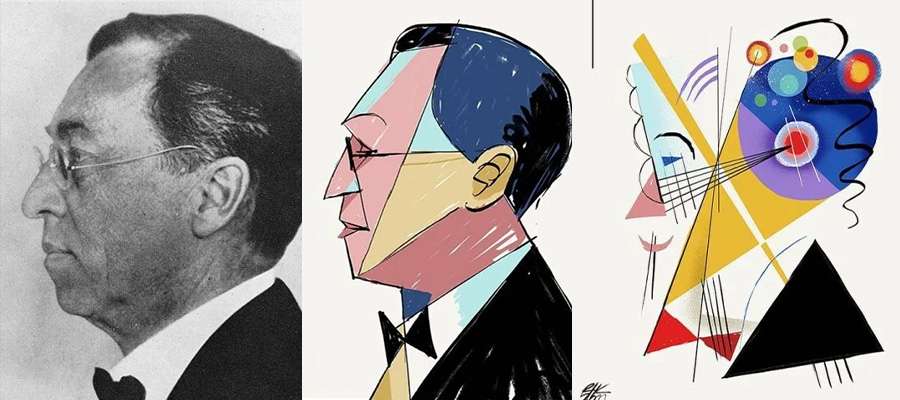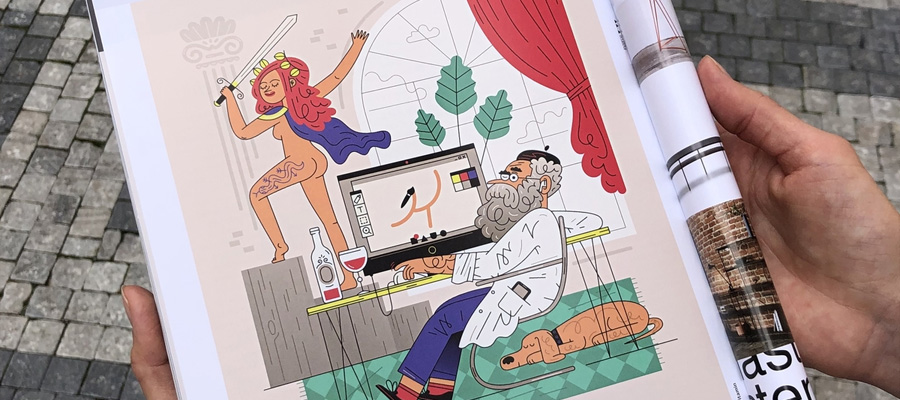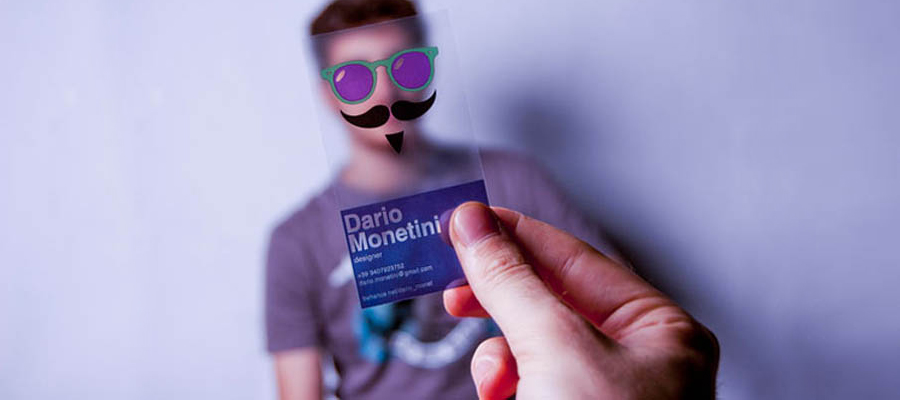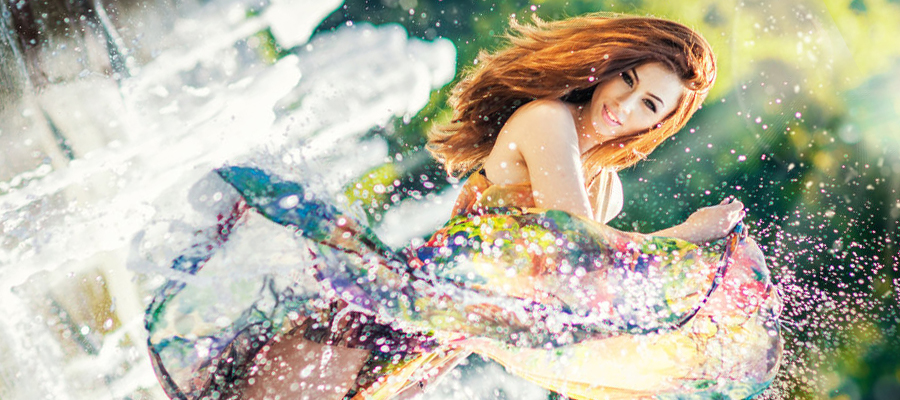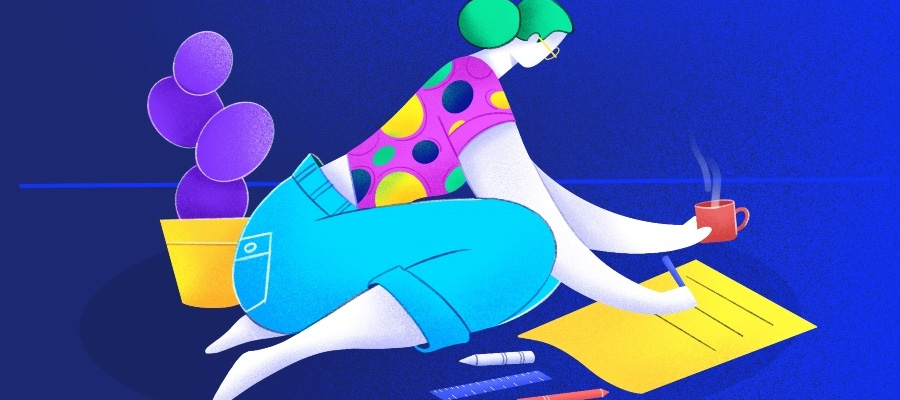Creativity is not a gift that only some people have. It is a skill that can be learned and developed by anyone who is willing to explore new possibilities, challenge assumptions, and take risks. Creativity is the ability to generate original and valuable ideas that can solve problems, improve situations, or create something new. Creativity is essential for personal and professional growth, as well as for the progress of humanity. But what is the creativity meaning exactly? Let's explore the creativity definition from the lens of psychology.

illustration byPaula Posadas Alvarez
Welcome to a world where creativity knows no bounds and your imagination takes flight. In this creativity article, we invite you to embark on a remarkable journey of self-expression, inspiration, and boundless possibilities. Discover the transformative power of embracing your creativity and unleash a torrent of brilliance that will set your soul on fire. Dive into the psychology of creativity and learn how to harness your creative thinking to drive innovation, whether you work in creative labs, with creative audio and sound, at a creative company, or use creative technology and software.
But how can you tap into your creative potential and use it to achieve amazing results? In this article on creativity in psychology, we will share with you some practical tips and strategies that will help you embrace your creative journey and ignite your passion. You will learn how to:
- Overcome the common barriers and myths that block your creativity
- Find your creative inspiration and motivation
- Develop a creative mindset and habits
- Use effective tools and techniques to generate and evaluate ideas
- Apply your creativity to different domains and contexts
- Showcase your creativity and get recognition
By following these steps, you will be able to unlock your limitless potential and create a positive impact in your life and the world around you. Becoming creative is a journey that requires intelligence, divergent thinking, and a willingness to innovate.
Overcome the Common Barriers and Myths that Block Your Creativity
Before you can unleash your creativity, you need to overcome the common barriers and myths that block your creative potential. These barriers can be internal, such as fear, stress, self-doubt, or lack of motivation, or external, such as rules, restrictions, groupthink, or resource constraints. These barriers can prevent you from generating, expressing, or implementing your creative ideas effectively and hinder your ability to innovate and engage in problem-solving.
What is creativity? Can we define creativity? Or a creative thinking definition?
Fortunately, there are some proven strategies and tools that can help you overcome these barriers and boost your creative confidence, and we reffering of something on top of what creative artificial intelligence you're thinking of. Here are some of them:
- To overcome fear of failure, criticism, or rejection, you need to adopt a growth mindset and see failure as a learning opportunity. You also need to create a safe and supportive environment where you can experiment, test, and iterate your ideas without judgment. You can use tools such as the feedback loop, the failure resume, and the learning journal to embrace failure, learn from it, and improve your ideas. This process of trial and error is key to the creative process and driving innovation.
- To overcome stress and anxiety, you need to manage your time and energy wisely and avoid procrastination and perfectionism. You also need to practice self-care and relaxation techniques that can help you calm your mind and body. You can use tools such as meditation, breathing exercises, yoga, or music to reduce stress and enhance your creativity. Taking care of your mental health is crucial for maintaining your creative ability and intelligence.
- To overcome self-doubt and lack of confidence, you need to acknowledge your strengths and achievements and celebrate your successes. You also need to seek constructive feedback and guidance from mentors, peers, or experts who can help you improve your skills and knowledge. You can use tools such as the SWOT analysis, the positive affirmation, and the gratitude journal to boost your self-esteem and confidence. Believing in your creative talent and intelligence is essential for producing original work.
- To overcome lack of motivation and inspiration, you need to find your passion and purpose and align them with your goals and values. You also need to seek new experiences and challenges that can stimulate your curiosity and interest. You can use tools such as the vision board, the bucket list, and the inspiration journal to spark your motivation and inspiration. Engaging in creative pursuits that excite you will fuel your drive to innovate.
- To overcome rules and restrictions that limit your creative freedom, you need to challenge the status quo and question the assumptions and norms that govern your field or industry. You also need to explore different perspectives and approaches that can help you find new opportunities and solutions. You can use tools such as the problem statement, the 5 whys, the SCAMPER technique, and the reverse brainstorming to redefine the problem and generate alternative ideas. Divergent thinking is key to breaking free of constraints and driving innovation.
- To overcome groupthink that reduces the diversity and quality of ideas, you need to encourage diversity and inclusion in your team or organization and foster constructive debate and collaboration. You also need to solicit different opinions and perspectives from various sources and stakeholders. You can use tools such as the brainstorming rules, the six thinking hats, the devil's advocate, and the nominal group technique to stimulate creative thinking, avoid groupthink, and reach consensus. Leveraging diverse viewpoints and intelligence is crucial for innovation.

illustration by Hurca!
By applying these strategies and tools, you will be able to remove the common barriers that block your creativity and unleash your full creative potential. Overcoming these obstacles is essential for becoming creative and driving innovation in your creative domains. A creativity example could be an artist who uses their cognitive abilities, originality, and creative skills to produce novel ideas and creative solutions through artistic expression. The creative process involves creative expression, creative thinking, and ultimately creative products that demonstrate their creative genius. This relies on underlying neural processes and creative lifestyles that foster the right personality traits for creativity to flourish.
How to Seek Out New Experiences and Challenges
- Seek out new experiences and challenges that can stimulate your curiosity and interest. You can do this by traveling to new places, learning new skills, taking on new projects, or joining new communities. New experiences and challenges can expose you to different perspectives, ideas, and cultures that can inspire your creativity. As the writer Marcel Proust said, "The real voyage of discovery consists not in seeking new landscapes, but in having new eyes." Engaging in novel experiences is key to the creative process and generating creative insights.
- Surround yourself with creative people and sources of inspiration. You can do this by following people who inspire and motivate you on social media, reading books or articles by creative authors, watching movies or shows that spark your imagination, or listening to music or podcasts that energize your mood. Creative people and sources of inspiration can influence your thinking, stimulate your emotions, and trigger your imagination. Exposing yourself to creative individuals and their creative output can help fuel your own originality and innovation.
- Seek out feedback and guidance from mentors, peers, or experts. You can do this by joining online or offline groups or communities that share your interests, attending workshops or courses that teach you new skills or techniques, or reaching out to people who have achieved what you aspire to do. Feedback and guidance can help you improve your skills, learn from others' experiences, and discover new opportunities and possibilities. Tapping into the intelligence and expertise of others is invaluable for refining your creative ideas and driving innovation.
- Set yourself goals and challenges that excite you and align with your passion and purpose. You can do this by writing down your vision and mission statements, creating a vision board or a bucket list, or using the SMART goals framework to set specific, measurable, achievable, relevant, and time-bound objectives. Goals and challenges can help you focus your attention, direct your efforts, and measure your progress. Having clear targets to work towards is essential for channeling your creativity and producing innovative solutions to problems.
Develop a Creative Mindset and Habits
Another key factor that influences your creativity is your mindset and habits. Your mindset is the way you think about yourself and your abilities. Your habits are the actions you take regularly that shape your behavior and outcomes. Having a creative mindset and habits can help you cultivate and sustain your creativity over time.

illustration by Zhenya Lukovenko
But how can you develop a creative mindset and habits? How can you train your brain to be more creative? Here are some tips and ideas that can help you:
- Adopt a growth mindset that embraces challenges, seeks feedback, and views failure as a learning opportunity. A growth mindset can help you overcome self-doubt, fear, and fixed beliefs that limit your creative potential. As the psychologist Carol Dweck said, “In a growth mindset, people believe that their most basic abilities can be developed through dedication and hard work—brains and talent are just the starting point.”
- Practice mindfulness and meditation that can help you calm your mind, reduce stress, and enhance your focus. Mindfulness and meditation can also help you access your imagination network, the part of the brain that enables you to construct personal meaning, imagine other perspectives, and reflect on mental and emotional states. As the writer Elizabeth Gilbert said, “Creativity itself doesn’t care at all about results—the only thing it craves is the process.”
- Seek out new experiences and challenges that can stimulate your curiosity and interest. You can do this by traveling to new places, learning new skills, taking on new projects, or joining new communities. New experiences and challenges can expose you to different perspectives, ideas, and cultures that can inspire your creativity. As the writer Marcel Proust said, “The real voyage of discovery consists not in seeking new landscapes, but in having new eyes.”
- Surround yourself with creative people and sources of inspiration. You can do this by following people who inspire and motivate you on social media, reading books or articles by creative authors, watching movies or shows that spark your imagination, or listening to music or podcasts that energize your mood. Creative people and sources of inspiration can influence your thinking, stimulate your emotions, and trigger your imagination.
- Seek out feedback and guidance from mentors, peers, or experts. You can do this by joining online or offline groups or communities that share your interests, attending workshops or courses that teach you new skills or techniques, or reaching out to people who have achieved what you aspire to do. Feedback and guidance can help you improve your skills, learn from others’ experiences, and discover new opportunities and possibilities.
- Set yourself goals and challenges that excite you and align with your passion and purpose. You can do this by writing down your vision and mission statements, creating a vision board or a bucket list, or using the SMART goals framework to set specific, measurable, achievable, relevant, and time-bound objectives. Goals and challenges can help you focus your attention, direct your efforts, and measure your progress.
- Experiment with different tools and techniques that can help you generate and evaluate ideas. You can do this by using brainstorming rules, mind mapping, SWOT analysis, reverse brainstorming, brainwriting, SCAMPER technique, and reverse brainstorming to generate alternative ideas. You can also use tools such as the feedback loop, the failure resume, the learning journal, the problem statement, the 5 whys, the six thinking hats, the devil’s advocate, and the nominal group technique to evaluate and improve your ideas.
- Practice creative thinking skills that can help you enhance your cognitive abilities and flexibility. You can do this by playing games or puzzles that challenge your logic, memory, or spatial skills, such as chess, sudoku, crosswords, or Rubik’s cube. You can also practice skills such as divergent thinking, convergent thinking, lateral thinking, and critical thinking that can help you generate more ideas, find connections between ideas, solve problems in novel ways, and assess the validity and relevance of ideas.
- Cultivate creative habits that can help you maintain your creativity and productivity. You can do this by setting a regular time and place for your creative work, keeping a notebook or a digital app to record your ideas and insights, reviewing and revising your ideas periodically, seeking inspiration from various sources and domains, and rewarding yourself for your achievements and efforts.
Use Effective Tools and Techniques to Generate and Evaluate Ideas
One of the key skills that you need to master as a creative thinker is how to generate and evaluate ideas effectively. Generating ideas is the process of coming up with original and valuable ideas that can solve problems, improve situations, or create something new. Evaluating ideas is the process of assessing the validity, relevance, and feasibility of ideas and selecting the best ones for further development or implementation.

illustration by Csilla Gyarfas
But how can you use effective tools and techniques to generate and evaluate ideas? How can you make sure that your ideas are not only creative but also useful and actionable? Here are some tips and ideas that can help you:
- To generate ideas, you need to use tools and techniques that can help you break away from conventional thinking, explore different possibilities, and find new connections. Some of the tools and techniques that you can use are brainstorming, mind mapping, SWOT analysis, reverse brainstorming, brainwriting, SCAMPER technique, and six thinking hats. These tools and techniques can help you generate a large number of diverse and original ideas in a short period of time.
- To evaluate ideas, you need to use tools and techniques that can help you analyze, critique, and improve your ideas. Some of the tools and techniques that you can use are feedback loop, failure resume, learning journal, problem statement, 5 whys, devil’s advocate, and nominal group technique. These tools and techniques can help you test your assumptions, learn from your mistakes, and refine your ideas based on evidence and feedback.
- To select the best ideas, you need to use tools and techniques that can help you compare, rank, and prioritize your ideas. Some of the tools and techniques that you can use are decision matrix analysis, paired comparison analysis, Pareto analysis, cost-benefit analysis, and feasibility study. These tools and techniques can help you weigh the pros and cons of each idea, consider the criteria and constraints of your problem or opportunity, and choose the most viable and desirable idea for further development or implementation.
Apply Your Creativity to Different Domains and Contexts
One of the key benefits of being a creative thinker is that you can apply your creativity to different domains and contexts. Domains are the fields or areas of human activity that require creativity, such as science, art, literature, music, business, education, and so on. Contexts are the situations or environments that influence or facilitate creativity, such as culture, society, organization, team, and so on.
But how can you apply your creativity to different domains and contexts? How can you adapt your skills and knowledge to different problems or opportunities? Here are some tips and ideas that can help you:
- To apply your creativity to different domains, you need to understand the characteristics and requirements of each domain. You also need to acquire the relevant skills and knowledge that are needed for each domain. You can do this by studying the history and theory of each domain, learning from the experts and role models of each domain, and practicing the techniques and methods of each domain.
- To apply your creativity to different contexts, you need to understand the factors and conditions that affect or enable creativity in each context. You also need to adjust your style and approach to fit each context. You can do this by observing and analyzing the culture and norms of each context, communicating and collaborating with the people and stakeholders of each context, and respecting and appreciating the diversity and uniqueness of each context.
Showcase Your Creativity and Get Recognition
One of the key goals of being a creative thinker is to showcase your creativity and get recognition. Showcasing your creativity is the process of sharing your ideas and work with others, such as potential clients, customers, employers, or collaborators. Getting recognition is the process of receiving feedback, appreciation, or rewards for your ideas and work, such as praise, testimonials, referrals, awards, or income.

illustration by Yaro Zubko
But how can you showcase your creativity and get recognition? How can you build your reputation and visibility as a creative thinker? Here are some tips and ideas that can help you:
- To showcase your creativity, you need to use tools and platforms that can help you display your ideas and work effectively. You also need to target the right audience and market for your ideas and work. You can do this by creating a portfolio or a website that showcases your best work, using social media or blogs to share your work and insights regularly, joining online or offline communities or networks that relate to your domain or context, and participating in events or competitions that showcase your work.
- To get recognition, you need to use tools and strategies that can help you collect feedback and testimonials from others. You also need to seek opportunities and rewards that can help you advance your career or business. You can do this by asking for feedback or testimonials from your clients, customers, peers, mentors, or experts, using online platforms or tools that allow ratings, reviews, or comments on your work, applying for grants, scholarships, awards, or residencies that support your work, and pitching your work to potential clients, customers, employers, or collaborators.
Nurturing the Spark Within
Cultivating a Creative Mindset Embrace the essence of creativity as we delve into the art of nurturing your inner spark. Learn how to cultivate a creative mindset that fosters curiosity, embraces experimentation, and fuels innovation. Discover the joy of exploring new ideas, breaking free from limitations, and unlocking the full potential of your unique talents.
Embracing the Canvas
Expressive Artistry in Various Mediums Dive into the realm of expressive artistry and unleash your creative prowess across various mediums. Whether it's painting, sculpting, photography, or mixed media, discover the power of self-expression through art. Let the colors dance on your canvas, the textures come alive under your fingertips, and witness the transformation of emotions into tangible masterpieces.
Crafting a Narrative
The Power of Storytelling in Communication Unleash the captivating power of storytelling and breathe life into your communication. Explore the art of crafting narratives that touch hearts, inspire minds, and create lasting connections. From captivating anecdotes to compelling brand stories, learn how to wield the magic of words to engage, entertain, and leave an indelible impression on your audience.
Innovative Solutions
Unlocking Creativity in Problem-Solving Embrace the role of creativity as a catalyst for innovative solutions. Discover how to leverage your creative thinking to tackle challenges, solve problems, and drive positive change. Unearth unconventional approaches, embrace fresh perspectives, and witness the transformation of obstacles into stepping stones on your journey towards success.

illustration by by Magdalena Koscianska
Designing a World of Inspiration
The Artistry of Visual Communication Step into the world of visual communication and become a master of design. Explore the principles of graphic design, typography, and visual storytelling to create compelling visuals that resonate with your audience. Unlock the ability to communicate ideas, evoke emotions, and leave a lasting visual impact that sets your brand apart.
The Intersection of Art and Technology
Embracing the Digital Renaissance Immerse yourself in the digital renaissance and embrace the convergence of art and technology. Discover the endless possibilities offered by digital art, virtual reality, augmented reality, and immersive experiences. Embrace the fusion of creativity and technology to push boundaries, redefine artistic expression, and shape the future of the creative landscape.
Fostering Collaboration and Inspiration
The Power of Creative Communities Experience the transformative power of collaboration and find inspiration within creative communities. Connect with like-minded individuals, share ideas, and engage in meaningful exchanges that elevate your creative journey. Discover the joy of collective inspiration, mutual support, and the endless opportunities that arise when passionate minds come together.
Embracing Omnipotentiality: Embodying the Power of Versatility
Discover the fascinating concept of being an omnipotentialite, where creativity knows no boundaries. Embrace your ability to excel in multiple domains, explore diverse passions, and embrace the joy of continuous learning. Embody the power of versatility and unleash your full creative potential across a multitude of disciplines.
Be Creative!
Embrace the call of creativity and embark on a journey that will forever change the way you perceive the world. Ignite your passion, unlock your limitless potential, and embrace the beauty of self-expression through various artistic avenues. Embrace the freedom to create, the joy of sharing, and the impact that your unique voice can have on the world. Let your creative spirit soar, and may your journey be filled with inspiration, growth, and boundless success.
Creativity is a skill that can be learned and developed by anyone who is willing to explore new possibilities, challenge assumptions, and take risks. Creativity is the ability to generate original and valuable ideas that can solve problems, improve situations, or create something new. Creativity is essential for personal and professional growth, as well as for the progress of humanity.
In this article, we have shared with you some practical tips and strategies that will help you embrace your creative journey and ignite your passion. You have learned how to:
- Overcome the common barriers and myths that block your creativity
- Find your creative inspiration and motivation
- Develop a creative mindset and habits
- Use effective tools and techniques to generate and evaluate ideas
- Apply your creativity to different domains and contexts
- Showcase your creativity and get recognition
By following these steps, you will be able to unlock your limitless potential and create a positive impact in your life and the world around you. We hope you have enjoyed this article and found it useful. Now go ahead and unleash your creativity!
